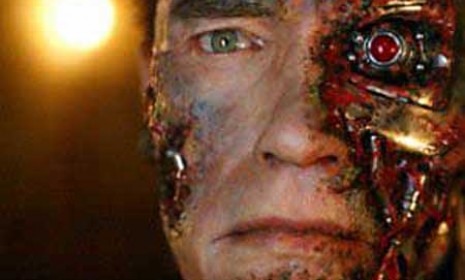Will 'Terminator-style' contact lenses become a reality?
Scientists unveil their vision of the future by fitting a contact lens with a rudimentary LED display

Imagine having streams of helpful digital information beamed directly to the surface of your contact lenses. That's the dream on which engineers from the University of Washington are working. They've already succeeded in creating a computerized contact lens embedded with a tiny LED that lights up when a wireless signal is sent to it. Here, a brief guide:
How does the prototype work?
This "Terminator-style" accessory is largely made of soft plastic, says Alyssa Danigelis at Discovery. The center of the lens is fitted with a "custom-designed LED" made of sapphire. A circular antenna lines the "inside lip of the lens," which allows researchers to send radio transmissions and control the single-pixel display on the LED, which flashes on and off when it receives a signal.
The Week
Escape your echo chamber. Get the facts behind the news, plus analysis from multiple perspectives.

Sign up for The Week's Free Newsletters
From our morning news briefing to a weekly Good News Newsletter, get the best of The Week delivered directly to your inbox.
From our morning news briefing to a weekly Good News Newsletter, get the best of The Week delivered directly to your inbox.
And the person wearing the contact can see the light?
Not quite. With the plastic lens alone, the LED would be too close to a person's eye to let him see the light. However, researchers fashioned a separate, "non-computerized contact" made out of several ultra-thin lenses, each less than a micron thick, says Danigelis. The idea was that this additional lens could bend light, allowing the contact wearer to see the glow. It appears to work.
Any other problems?
The stack of ultra-thin lenses was tested on rabbits. Because these lenses are made of a hard plastic that "doesn't allow the eye to breathe," they can only be worn "a few minutes at a time," says Chenda Ngak at CBS News. The good news? Rabbits' eyes didn't show any signs of abrasions or thermal burning.
A free daily email with the biggest news stories of the day – and the best features from TheWeek.com
So what good is this innovation?
Once all the kinks are eventually worked out, the hope is that this technology will let people see "all kinds of hands-free information," says the Fiona Macrae at Britain's Daily Mail, including text messages, social network content, and map directions. Researchers hope to have fully functional contact lens displays ready in the next 10 years.
Sources: CBS News, Daily Mail, Discovery
-
 Political cartoons for December 14
Political cartoons for December 14Cartoons Sunday's political cartoons include a new White House flag, Venezuela negotiations, and more
-
 Heavenly spectacle in the wilds of Canada
Heavenly spectacle in the wilds of CanadaThe Week Recommends ‘Mind-bending’ outpost for spotting animals – and the northern lights
-
 Facial recognition: a revolution in policing
Facial recognition: a revolution in policingTalking Point All 43 police forces in England and Wales are set to be granted access, with those against calling for increasing safeguards on the technology